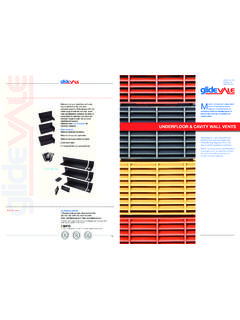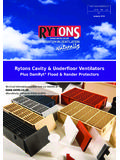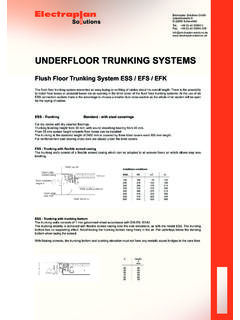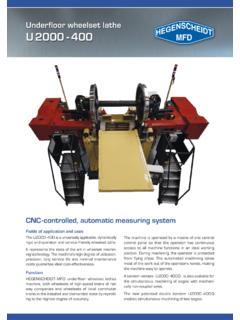Transcription of RADON SOLUTIONS IN HOMES
1 This Good Repair Guide offers guidance to builders and homeowners installing RADON sump systems in HOMES . It covers the installation of both active (fan-assisted) and passive sump systems. Advice is also given on system maintenance and what to do if the system fails to adequately reduce RADON Good Repair Guide is Part 3 in a 3-Part set and replaces the guidance given in BRE Report BR 227. Part 1 covers underfloor ventilation and Part 2 covers positive house guide is split into three sections: introduction to RADON and sump systems guidance on installing sump systems, including worksheets maintaining systems and what to do if a sump system does not reduce RADON levels is a naturally occurring radioactive gas that is present in all buildings.
2 Prolonged exposure to high levels causes lung cancer. The Health Protection Agency (HPA) recommends that householders with concentrations above the action level (200 Bq m-3) should reduce their RADON concentrations as far as they can and ideally to below the target level (100 Bq m-3). Where can sump systems be used?These systems can be used on any building where: there is a capping over the ground, such as a concrete groundbearing slab there is concrete capping to the soil beneath a suspended timber floor a standby sump was provided during construction (in newer HOMES ); see pages 2 and SOLUTIONS IN HOMESR adon sump systemsChris ScivyerGOOD REPAIR GUIDE GRG 37 Part 3 Figure 1: Generic sump systemsExternally constructed sump with low-level exhaustInternally constructed sump with high-level exhaustExternally constructed sump with high-level exhaustExternally constructed sump with low-level exhaust to a timber fl oor with concrete capping to the soil below2 RADON SOLUTIONS IN HOMES : RADON SUMP SYSTEMS GRG 37 PART 3 Internally constructed sumpFigure 4 provides detailed instructions for internally constructed sumps.
3 The main benefit of internally constructed sumps is that the sump can be more centrally placed within the building. Unfortunately, this creates more disruption for the householder and it may be difficult to conveniently site the sump. Prefabricated sumpsThe main benefit of prefabricated sumps is the ease of establishing a manifold of suction points. However, they will require more excavation and reinstatement of the floor afterwards (Figure 5).Care should be taken when breaking out to avoid damaging steel reinforcement or concealed services such as electricity cables or water pipes. Important tips Avoid locating the sump near to an open-flued appliance such as an open fire, gas fire or boiler that draws air from a room.
4 It is very important that the sump does not draw flue gases into the room. To minimise noise the fan should be placed away from frequently occupied rooms, eg living rooms and properties (built since the early 1990s)It is important to check whether properties have been constructed with a standby sump (Figure 6). Properties with solid concrete floors, built since the early 1990s or so in areas of the country where RADON risk is greatest, are likely to have been built with preventive measures. Original drawings of the property may indicate the position of the sump. Alternatively, the presence of a sump would be indicated by a short length of 110 mm (4 inch) diameter pipe capped off close to the outside of the building.
5 If a sump exists, it can be activated by adding a fan to the pipe. Number of sumps requiredA single sump is generally sufficient for a typical dwelling. For most houses, a single sump and fan will have an influence over an area of 250 m2 (a radius of approximately 9 m around the sump). If the subsoil is particularly permeable a sump may be effective as much as 15 m from the sump. However, obstructions below the floor slab may reduce effectiveness. Occasionally, larger or older houses may need more than one sump. An additional sump can be attached to the original fan by extending the pipework to include the second sump so that both sumps are powered by one fan.
6 Alternatively, a second, separate sump system could be installed to target the specific problem area. Sump systems are inappropriate for timber floors laid over bare earth unless additional work is carried out first to cap off the soil. In this case, refer to Parts 1 and 2 of this Good Repair Guide[1, 2].What is a sump?A sump is simply an underfloor space or cavity into which a pipe is inserted and used to extract RADON . The cavity prevents obstruction of the pipe with loose fill from the underfloor space. How does a sump work? RADON gas does not drain into the sump but is drawn through the underfloor fill to the sump by the suction (pressure difference) created by an electric fan or the stack effect (warm air rising) and wind action on a passive sump pipe.
7 Active sump systemsAn open space of about the size of a bucket (volume approximately 10 L) is excavated beneath the ground floor, fitted with pipework and an electric fan. Active sump systems are the most effective at reducing indoor RADON concentrations, particularly those with the highest RADON sumpsPassive sumps rely on the natural stack effect and wind action to extract RADON from the ground, instead of using an electric fan. The absence of running costs makes the installation of passive sumps attractive, but they are much less effective in reducing RADON than active sumps. There are four generic positions for sumps and associated pipework (Figure 1).
8 Specifi cations for installing active sump systemsFigures 2 4 are technical worksheets for installing active sump systems, both with low- and high-level exhausts. GUIDANCE ON INSTALLING SUMP SYSTEMSC onstructionSumps can be constructed internally or constructed mini sumpFigures 2 and 3 provide detailed instructions for externally constructed sumps. The main stages of sump construction are: 1. Break out or core drill a 120 mm (4 inch) diameter hole through the external wall just below the floor slab. 2. Excavate about a bucketful of material (volume approximately 10 L) from under the floor slab. 3. Attach a pipe to link the sump to an electric fan in order to exhaust RADON outdoors.
9 A good seal must be made where the pipe runs through the wall (see Step 3 in Figures 2 and 3 and the Sealing section on page 7).3 RADON SOLUTIONS IN HOMES : RADON SUMP SYSTEMS GRG 37 PART 3248391572849175636 Check that the ground fl oor construction is solid concrete or suspended timber with concrete capping to the soil below. For most houses a single sump and fan will have an infl uence over an area of 250 m2 (a radius of approximately 9 m around the sump). If the subsoil is particularly permeable a sump may be effective as much as 15 m from the sump. Find a location away from drains where there are no doors, windows or ventilation Break out or core drill a 120 mm diameter hole through the external wall just below the fl oor Excavate about a bucketful of material (volume approximately 10 L) from under the fl oor slab to form a Install a short piece of 110 mm diameter pipe to tilt down into the sump and seal it to the wall to minimise suction of air from within the wall or If the fan is to be mounted vertically (as in the lower diagram)
10 Then once the pipe has set in the wall attach an short radius bend and short length of vertical Attach an in-line centrifugal duct fan to the pipe from the sump using a rubber reducer coupling. (Typical fan fl ow rate 177 m3/h at a pressure difference of 200 Pa, 70 W power consumption.)6 Support the fan from a bracket fi xed back to the Wire the fan back to a fused spur inside the If accessible, seal the joint between the fl oor and wall adjacent to the sump to minimise suction of air from the Some fans require weather protection a wooden box with a vent grille in front of the fan outlet can be 2: Worksheet for two examples of generic externally constructed mini sump systems with low-level exhausts4 RADON SOLUTIONS IN HOMES : RADON SUMP SYSTEMS GRG 37 PART 31932116871054 Check that the ground fl oor construction is solid concrete or suspended timber with concrete capping to the soil below.







